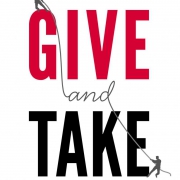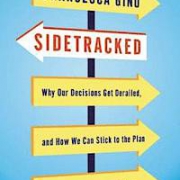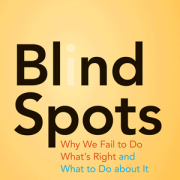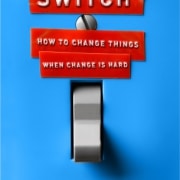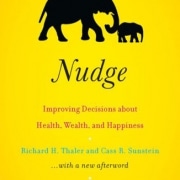Cultivating Conscience
Cultivating Conscience: How Good Laws Make Good People
by Lynn Stout (public library)
Summarized by David Newman
Overview
Conscience, or unselfish prosocial behavior, is a real and powerful force. A growing body of empirical evidence shows how conscience both shapes our lives and is shaped by our society. Yet for decades, scholarly experts (especially lawyers and economists) have been steeped in the behavioral model of homo economicus, a man whose only interest is in rationally maximizing his own material gain. Lynn Stout pushes back against this conception of human conduct, showing how we have blinded ourselves to our own goodness in spite of an abundance of data from experimental gaming, evolutionary psychology, law and other disciplines suggesting that people are motivated by more than just self-interest. Stout offers a new model of behavior, pairing cost/benefit analysis with social context (divided into three social cues: authority, imitation, and empathy). It is the right social context that enables us to follow our conscience, determining whether we act as prosocial Dr. Jekylls or antisocial Mr. Hydes. The final third of Cultivating Conscience focuses on the role of law in setting up that social context. To a greater degree than we suppose, the orderliness of our society depends on our willingness to be good.
Application to Ethical Systems
Stout’s three-factor model of social context provides an elegant and data-driven explanation for how and when human beings act according to their conscience, balanced against the incentives of material gain and risk. Any leader or manager designing a system to encourage ethical behavior should attend to how the system promotes reliance on conscience using authority, imitation, and empathy as guideposts. An ethical system that relies too heavily on material incentives signals that selfishness and gaming are normal and expected. People are most likely to behave ethically when (a) they hear expectations of ethical conduct from a respected authority, (b) they are embedded in an environment of noticeably upright conduct, and (c) they are made aware of the benefits to others of their ethical behavior. When these conditions are met, most people are more than willing to endure a small amount of self-sacrifice. That is the power of conscience.
Chapter Summaries
Chapter 1: Franco’s Choice
Stout refers to Franco Gonzalez, who found $203,000 that fell off an armored car and turned the money in to the police. His example cuts against the grain of the longstanding concept in modern thought of homo economicus: the selfishly rational man. The homo economicus account and those brought up with its teachings now pervade law, business, government and education.
Stout contends that conscience (what she calls unselfish prosocial behavior) plays far more of a role in our interactions and transactions than we realize. Science has begun a rigorous study of how humans behave in ways that do not materially benefit themselves but do benefit others. This includes not only “active” altruism (e.g. donating money) but “passive” altruism (i.e. ethics).
Conscience is a real, common, powerful and important phenomenon. We do not always need to rely on crude material rewards and punishment to encourage prosocial behavior. Therefore law, to the extent that it is about promoting unselfish prosocial behavior, should take an interest in the science of conscience. Cultural habits of unselfish prosocial behavior (“social capital”) are linked not only to happiness but to economic prosperity, so a healthy society will cultivate conscience. In this, law has a critical role to play, and the aim of Stout’s work is to explore how it can best do so.
Chapter 2: Holmes’ Folly
Until the 19th century, law and morality were entwined; scholars seriously considered the role of conscience in influencing behavior. But Oliver Wendell Holmes pivoted the legal academy in a new direction in The Path of the Law, stating that one must view the law like a “bad man, who cares only for the material consequences.” Holmes was among the first great thinkers to apply the tools of economics to understanding the legal system; this was the birth of Economic Man.
In the 1960s, economists began using the theory of people as rational maximizers of their own self-interest to analyze not only markets, but households, firms, politics, and the legal system. Law and economics became a dominant movement in legal academia, teaching a generation the central tenet of homo economicus: “people respond to incentives.” Meaning: material incentives.
But the idea that people are fundamentally amoral, caring only for material incentives, has not sat well with all experts. Defenders of Economic Man have offered three primary arguments:
1. Perhaps people maximize not wealth but “utility,” which could derive from ethical behavior. But this reduces rational choice theory to tautology and robs it of much of its predictive value.
2. The “law and norms” school of thought (from the work of Robert Ellickson) shows how social conventions interact with law to influence behavior. But norms-based models continue to neglect conscience to emphasize how people follow social norms mainly out of self-interest, which has limited their ability to explain much behavior (e.g. why do people obey norms even when alone?).
3. The homo economicus model might not be perfect, but it’s the best behavioral model we have. Conscience may influence us, but it is eccentric, poorly understood, and impossible to predict.
The “law and society” school cleaves closer to sociology, psychology and the humanities, which employ the model of homo sociologicus, a “blank slate” imprinted entirely by culture and society. But this account offers little predictive value or practical guidance for policymakers.
Economic Man and rational choice have achieved broad acceptance, despite evidence that a pure focus on material incentives rarely produces the best outcomes (e.g. No Child Left Behind, pay for performance). Stout claims this is because people in general (and particularly experts in law or economics) tend not to notice unselfish prosocial behavior. We’re blind to our own goodness.
Chapter 3: Blind to Goodness: Why We Don’t See Conscience
Homo economicus exhibits 5 of the DSM-IV’s 7 classic traits of Antisocial Personality Disorder. Yet psychopaths are rare, so why think that rational selfishness is an accurate description of human behavior? Because most people tend not to notice common forms of unselfish behavior.
Civilized life depends on passive altruism restraining selfishness, but this is an invisible force. However, it can be seen in the laboratory: hundreds of studies demonstrate that subjects playing anonymous prisoner’s dilemma games choose cooperation over defection about half the time.
Stout suggests 9 reasons that work to blind even sophisticated observers to human goodness:
1. Confusing altruistic actions with altruistic feelings. Introspection makes us aware of “selfish” emotions that may underlie an act of generosity, even if the act itself is objectively unselfish.
2. The misunderstood nature of morality. That “morality” is used to describe idiosyncratic rules about diet, dress and sexual deportment makes many intellectuals view morality with suspicion. But every orderly society shares universal moral rules implicating conscience and selflessness.
3. The banality of goodness. Many unselfish acts are so commonplace as to be beneath notice. Active altruism is rare enough to draw attention, but passive altruism is taken for granted.
4. Small sacrifices go unnoticed. Many common forms of prosocial behavior involve but marginal self-sacrifice (giving directions, waiting in line, etc.), so they are not recognized as sacrificing. However, they may provide larger benefits to others and produce large aggregate social gains.
5. The peculiar salience of cheating. Human beings are particularly good at detecting cheating, and we pay more attention to selfish misbehavior than to instances where people behave well.
6. Naive realism. We tend to assume our perceptions accurately reflect reality, so when others behave in a way that seems inconsistent with our views, we assume they are biased or selfish.
7. The correlation between external and internal sanctions. Most societies are structured to reward actions that help others and to punish actions that harm others. The result is a strong correlation between conscience and law that makes people think that legal and social sanctions, not conscience, keep most people from injuring others and from breaking promises.
8. Darwinian doubts about altruists’ survival. It is easy for those with only passing familiarity with evolutionary theory to conclude that egoists must outcompete altruists for survival. But evidence shows that altruism is common, even outside the family. Evolution need not stamp out altruism.
9. Who studies homo economicus? Beliefs about others’ selfishness can be influenced by formal training, especially formal training in economics. Moreover, students and researchers in certain fields (like econ and law) focus on studying situations where people in fact behave selfishly. And people who go into such fields may be more self-regarding, so they assume others are selfish.
Chapter 4: Games People Play: Unselfish Prosocial Behavior in Experimental Gaming
Experimental gaming, or behavioral economics, has entered mainstream scholarship in recent years, thanks in part to the pioneership of Daniel Kahneman and Amos Tversky, who devised ingenious experiments to test how real people make decisions in an uncertain world. But most studies use gaming to challenge only the “rational” prong of “rational selfishness.”
However, from the beginning experimental gaming has shown that our behavior often violates the “selfish” part of the homo economicus model (e.g., the RAND prisoner’s dilemma games). Researchers have since begun to control the circumstances of experimental games to exclude extrinsic rewards for unselfish behavior, eliminating retaliation and reputation effects. And after hundreds of experiments, unselfish behavior has turned out to be both common and predictable. Across societies and cultures, experimental behavior goes against that of homo economicus.
Stout offers 3 fundamental lessons about unselfish behavior drawn from experimental gaming:
1. Social dilemma games: subjects choose to cooperate in social dilemma games about 40-60% of the time. Unselfish prosocial behavior (kindness, altruism) is endemic, even among strangers.
2. Ultimatum games: involving a proposer who makes an offer and a responder who accepts or rejects it, these show a different unselfishness: spite (sacrifice to harm another). Most proposers offer 40-50% of the total sum, and about half of all responders reject offers below 30%.
3. Dictator games: unlike in ultimatum games, the second player has no chance to respond and receives whatever the dictator is willing to share. Nonetheless, most dictators choose to share at least some portion of their initial stakes (about 20-30%), but less than in ultimatum games. Hence proposers in ultimatum games anticipate that treating a responder too poorly will prompt a spiteful punishment. Not only do people behave altruistically and spitefully, but they know that other people behave altruistically and spitefully–and plan accordingly. These second-order effects allow a large number of small, marginally unselfish behaviors to reinforce prosociality.
Chapter 5: The Jekyll/Hyde Syndrome: A Three-Factor Social Model of Unselfish Prosocial Gaming Behavior
Conscience must be understood to be of use in law and law enforcement. Relying on empirical findings, this chapter offers a simple model to predict when most people will act selfishly or not. Human behavior is sensitive to a variety of noneconomic variables, including social context. These variables can be manipulated in games to bring cooperation very close to 0% or 100%.
Stout’s model, summarized: Unselfish prosocial behavior toward strangers, including unselfish compliance with legal and ethical rules, is triggered by social context, including especially:
1. Instructions from authority. These trigger obedience (e.g., Milgram).
2. Beliefs about others’ prosocial behavior. These trigger conformity (e.g., Latané and Darley).
3. Magnitude of benefits to others. This triggers empathy (e.g., dictator games with a multiplier).
Prosocial behavior declines, however, as the personal cost of acting prosocially increases. Conversely, the lower the cost of unselfish action, the more likely unselfish action becomes.
It is critical to attend to “the cost of conscience” in policy and other ethical systems design. If we want people to be good, it is important not to tempt them to be bad. An over-reliance on material incentives often creates temptations. However, if you give conscience breathing room to work, expect that most people will be willing to make at least a small sacrifice to behave prosocially.
Chapter 6: Origins
Stout explores how unselfish behavior may have evolved through a multilevel narrative:
1. Moral development in individuals. Children start off selfish, but other-regarding behavior (both altruism and spite) increases with age and throughout adulthood. 1-2% of people are incapable of developing a conscience (psychopaths), and others can be traumatized by abuse or accident.
2. Moral development in species. Self-sacrifice does not seem a winning strategy for individual organisms. However, at the group level it offers clear advantages in promoting survival in difficult environments, so that more of the group can reproduce. Evolutionary biologists have developed several theories to explain how altruistic cooperation can evolve and survive in social species:
3. Kin selection. This theory predicts that altruistic behavior will be favored by natural selection only when it works to promote the survival of kin who share one’s genes. The closer two people are related, the more likely they will make sacrifices to benefit each other. But kin selection does not adequately explain altruism between strangers, including that seen in experimental games.
4. Reciprocal altruism. By exchanging favors with each other, otherwise selfish creatures make themselves better off. This requires the opportunity for repeated exchange and the cognitive ability to keep track of exchanges–and is probably a good explanation for superficially altruistic behavior in small groups. But it does not explain “generalized reciprocity”–altruistic cooperation in modern urban societies among strangers who will likely never see each other again.
5. The Big Mistake theory. We have lived with strangers for only a few hundred years. We may carry the evolutionary baggage of our ancestral environment, following a rule of thumb to start with cooperation and assume defection will be detected, which explains experimental gaming.
6. Partner selection. Even in modern society, if altruists can identify and interact only with other altruists, they can capture all the gains of their mutually “nice” behavior without having to tolerate the parasitic burden of selfish egoists. For instance, blushing when one is ashamed is a sign of prosociality. But cheaters can evolve to imitate cooperators and so will not disappear entirely.
7. Group level selection. A group of organisms that practices altruistic cooperation will do better than another group whose members practice selfishness. Although disfavored in the 1960s, this theory has gained traction in recent years through documentation of “altruistic punishment” (when people punish someone who has harmed or refused to cooperate with a third party) and “culture-gene coevolution” (institutional sanctions strengthen group selection of altruistic traits).
8. Costly signaling and sexual selection. Sexual selection depends in part on “fitness indicators,” often handicaps (like a peacock’s tail) signalling that an organism is a strong mating partner. A generous nature may be a fitness indicator, especially if observed by others in one’s community.
Three lessons: First, evolution is not inconsistent with widespread altruism. Second, we should be unsurprised if our altruistic behavior often “feels” subjectively selfish (it makes sense to evolve an internalized reward system to promote prosociality). Third, altruistic cooperation tends to occur only with other members of one’s ingroup (which can run from small to very large).
Chapter 7: My Brother’s Keeper: The Role of Unselfishness in Tort Law
Tort law discourages people from selfishly creating risks that impose external costs on others by determining when and how much someone who accidentally injures another’s person or property (the “tortfeasor”) must pay damages to compensate the person who was injured.
Economic analysis of tort law starts with two assumptions: First, the primary purpose of tort law is to deter accidents. Second, tortfeasors are selfish actors who happily impose external costs on others. But these two assumptions stand in tension, because tort law should not do much to deter rationally selfish actors. It can only be expected to work if most people have a conscience.
Stout discusses the pervasiveness of economic thinking in tort analysis, including Learned Hand’s formula for negligence: B<PL. If the burden of precautions is less than the probability of an accident multiplied by the cost of damages, an incautious tortfeasor has acted negligently. However, because of underenforcement and the encumbrances of the legal system, tort law does not require negligent tortfeasors to pay for all the damage they cause. At the same time, tort law sometimes imposes punitive damages to punish injurers for “outrageous” behavior.
Tort law recognizes that if most people are passive altruists, we can get by with weak external incentives to exercise care, because conscience will fill in the gap. For the rare individual who insists on acting like homo economicus even in social situations where the context says “take care,” punitive damages exist to prevent him from taking advantage of tort’s underenforcement.
Stout goes on to discuss the influence of tort law on corporations. Corporations are not psychopaths (are not purely homo economicus), but neither are they homo sapiens. The corporate context can shift human behavior, making it conscientious toward insiders and more psychopathic toward outsiders, using all the social levers of obedience, imitation and empathy. Selection bias may also affect the kinds of people hired at certain places, such as tobacco firms.
Because corporations lack conscience, they do not respond to tort incentives the way ordinary humans do. Undercompensation of victims may produce too little deterrence for corporations. Tort law, especially antitrust and RICO, is already moving to make conscienceless corporations more fully “internalize” their external costs, applying treble damages to legal violations.
Chapter 8: Picking Prosocial Partners: The Story of Relational Contract
Even more than tort law, the rational selfishness model of behavior dominates how most experts think about contracts. We expect selfish behavior in market exchange, and it usually works well. However, most contracts are incomplete (failing to address some potential issue or dispute), thanks to uncertainty, complexity, and unverifiability of terms. “Relational” contracts for complex, long-term, uncertain exchanges tend toward incompleteness. Here conscience plays a role.
Courts are often incompetent enforces of relational contracts, resolving disputes unpredictably. Purely selfish actors will exploit the large gaps in relational contracts and refuse to perform their promises, knowing that a lawsuit (if even litigated) might not succeed against them. Perhaps this behavior is deterred not by law but by fear of loss of reputation, in particular for “repeat players.” However, reputation is less of a concern for new players and individuals nearing retirement, and it is difficult for outsider observers to determine which party was at fault in a deal breakdown.
Stout suggests that the true story of relational contract is one of prosocial partners who trust each other and, to at least some extent, unselfishly look out for each other’s welfare. Parties to these contracts rely not only on court enforcement and reputational concern but on conscience. One of the implicit “terms” of a relational contract is an agreement each party will suppress her Mr. Hyde persona and adopt a Jekyll-esque attitude toward her contract partner, taking account of her partner’s welfare as well as her own in making decisions about how to perform.
The key to relational contracts is to pick a prosocial partner. Willingness to trust can signal one’s own trustworthiness. Conversely, distrusting others outs the relatively selfish and untrustworthy.
In an ambiguous contracting situation, the individual who hopes to rely on her contract partner’s conscience must make it clear that the situation calls for mutually considerate rather than arm’s length behavior. However, too much contractual detail can cause “motivational crowding” (as in prenups), signaling a social context in which selfishness is appropriate and expected. Lawyers thus play a valuable role as “scapegoats” who can take the blame for spelling out terms in detail. Courts, as authorities, can help by exhorting parties to relational contracts to act prosocially, and by giving nonbreaching plaintiffs a reputation for spite that will protect them in future exchanges.
Chapter 9: Crime, Punishment, and Community
Economists view criminal law (like all law) as a system of incentives. The price of crime is jail. But these incentives are often misaligned, as with 3-strikes rules handing life sentences to minor offenders. Imprisonment is expensive for taxpayers, keeps prisoners idle, and provides no material benefit to victims. Criminal law also punishes intent more than consequences. At a very deep level, the rules of criminal law simply don’t mesh with the assumption of selfishness.
Why should the standard penalties deter most of us but not all? Either the punishments are too weak, and most of us obey the law for some deeper reason (i.e., conscience), or they are strong enough but criminals don’t respond correctly to incentives. Deterrence’s competing rationales (incapacitation, rehabilitation, and retribution) are ill applied to the homo economicus model.
It is the reality of prosocial behavior that explains the systematic design of criminal law’s focus on imprisonment, its concern with subjective intent, and the nature of the tort/crime distinction.
1. Incapacitation and imprisonment: most people don’t commit crimes because they think they ought not to. This allows society to save money through “underpolicing.” We don’t actually want to have a system with punishments severe and certain enough to deter homo economicus. But for those stuck in “Mr. Hyde” mode (repeat offenders), longer prison sentences are one solution.
2. Prosociality and intent: state of mind matters because criminals have motives different from the rest of us–they shift into Hyde mode too easily. Criminal punishment is reserved for those who show indifference to others in social situations where indifference is inappropriate. The importance of intent can also be seen in the role remorse plays in lightening prison sentences.
3. Jekyll/Hyde Syndrome and the Tort/Crime distinction: tort law deals with otherwise-prosocial individuals who miscalculate a risk or fail to recognize a danger. Criminal law deals with purely selfish individuals who just don’t care. These are a threat to the public, so it is the public (via government prosecutors) that brings suit against criminal defendants.
Cost/benefit analysis is just one part of prosocial behavior. Conscience, as mediated by social context, also plays a role, and lawmakers should be ready to pull on the three social levels of obedience, imitation, and empathy in order to deter more crime at a lower cost.
1. Authority: Criminal law serves an expressive function in declaring that some harmful behavior is criminal as well as tortious. This influences behavior, but only if the authority is respected. Capricious application of law to identifiable subgroups (e.g. racial profiling) will diminish respect.
2. Imitation: Experimental gaming data show a causal link between broken windows policing and declining crime rates. Visible social order reduces crime via the human tendency to conform. Conversely, visible criminal behavior is contagious, “infecting” others who then violate the law.
3. Empathy: It is difficult to control “victimless” crimes like prostitution, gambling, polygamy, euthanasia, and recreational drug use. The only way to discourage victimless crimes is to use education and P.R. to convince both citizens and police such crimes are not truly victimless.
The 3-factor model shows that, by changing social context, criminal law changes what people want–and so shifts their behavior from purely selfish and asocial to unselfish and law-abiding.
Conclusion: Chariots of the Sun
There is a fundamental duality to human nature. In response to social cues, people will rapidly shift between prosocial, Dr. Jekyll-like behavior and selfish, Mr.-Hydish patterns of action. Civic order depends on our collective capacity to act like Dr. Jekyll and “internalize” rules, following them even when external sanctions are weak or missing. Rather than ignoring conscience, lawmakers will get better results if they put conscience into harness. So too can employers, reformers, educators, and civic and religious leaders.
Cultural systems of cooperative, trustworthy behavior are vital for economic growth, promoting market exchange and investment and discouraging opportunism and illegality. A growing body of empirical evidence supports this link. Researchers have also found a connection between self-reported happiness and ethical behavior. Prosocial behavior has psychological as well as monetary benefits. So we should be concerned by the data showing our society’s ethical decay.
Outside anonymous markets, emphasizing the power of material incentives and ignoring conscience not only hampers our ability to address social problems, it can make them worse. It is time to examine conscience as a force essential to our economic, social, and political lives.

